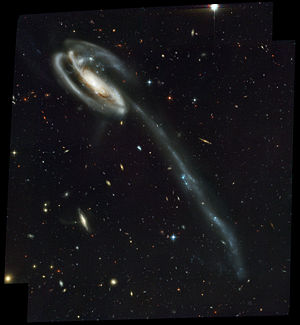
Tidal tail
Encyclopedia

Star
A star is a massive, luminous sphere of plasma held together by gravity. At the end of its lifetime, a star can also contain a proportion of degenerate matter. The nearest star to Earth is the Sun, which is the source of most of the energy on Earth...
s and interstellar gas that extends into space from a galaxy
Galaxy
A galaxy is a massive, gravitationally bound system that consists of stars and stellar remnants, an interstellar medium of gas and dust, and an important but poorly understood component tentatively dubbed dark matter. The word galaxy is derived from the Greek galaxias , literally "milky", a...
. Tidal tails occur as a result of galactic tide
Galactic tide
A galactic tide is a tidal force experienced by objects subject to the gravitational field of a galaxy such as the Milky Way. Particular areas of interest concerning galactic tides include galactic collisions, the disruption of dwarf or satellite galaxies, and the Milky Way's tidal effect on the...
forces between interacting galaxies. Examples of galaxies with tidal tails include the Tadpole Galaxy
Tadpole Galaxy
The Tadpole Galaxy is a disrupted barred spiral galaxy located 400 million light years from Earth toward the northern constellation Draco. Its most dramatic features are a trail of stars about 280 thousand light-years long and massive, bright blue star clusters.It is hypothesized that a more...
and the Mice Galaxies
Mice Galaxies
NGC 4676, or the Mice Galaxies, are two spiral galaxies in the constellation Coma Berenices. About 290 million light-years away, they are presently in the process of colliding and merging...
. Tidal forces can eject a significant amount of a galaxy's gas into the tail; within the Antennae Galaxies
Antennae Galaxies
The Antennae Galaxies are a pair of interacting galaxies in the constellation Corvus. They are currently going through a phase of starburst. They were discovered by William Herschel in 1785...
, for example, nearly half of the observed gaseous matter is found within the tail structures. Within those galaxies which have tidal tails, approximately 10% of the galaxy's stellar formation takes place in the tail. Overall, roughly 1% of all stellar formation in the known universe occurs within tidal tails.
Some interacting galaxy pairs have two distinct tails, as is the case for the Antennae Galaxies, while other systems have only one tail. Most tidal tails are slightly curved due to the rotation of the host galaxies. Those that are straight may actually be curved but still appear to be straight if they are being viewed edge-on.
History
The phenomena now referred to as tidal tails were first studied extensively by Fritz ZwickyFritz Zwicky
Fritz Zwicky was a Swiss astronomer. He worked most of his life at the California Institute of Technology in the United States of America, where he made many important contributions in theoretical and observational astronomy.- Biography :Fritz Zwicky was born in Varna, Bulgaria to a Swiss father....
in 1953. Several astrophysicists expressed their doubts that these extensions could occur solely as the result of tidal forces, including Zwicky himself, who described his own views as "unorthodox". Boris Vorontsov-Velyaminov
Boris Vorontsov-Velyaminov
Boris Aleksandrovich Vorontsov-Velyaminov was a Soviet/Russian astrophysicist. His name is sometimes given as Vorontsov-Vel'yaminov....
argued that the tails were too thin and too long (sometimes as large as 100,000 parsec
Parsec
The parsec is a unit of length used in astronomy. It is about 3.26 light-years, or just under 31 trillion kilometres ....
s) to have been produced by gravity alone, as gravity should instead produce broad distortions. However, in 1972, renowned astronomer Alar Toomre
Alar Toomre
Alar Toomre is an Estonian-born astronomer and mathematician who immigrated to the United States in 1949. He is a professor of applied mathematics at the Massachusetts Institute of Technology...
proved that it was indeed tidal forces that were responsible for the tails.

